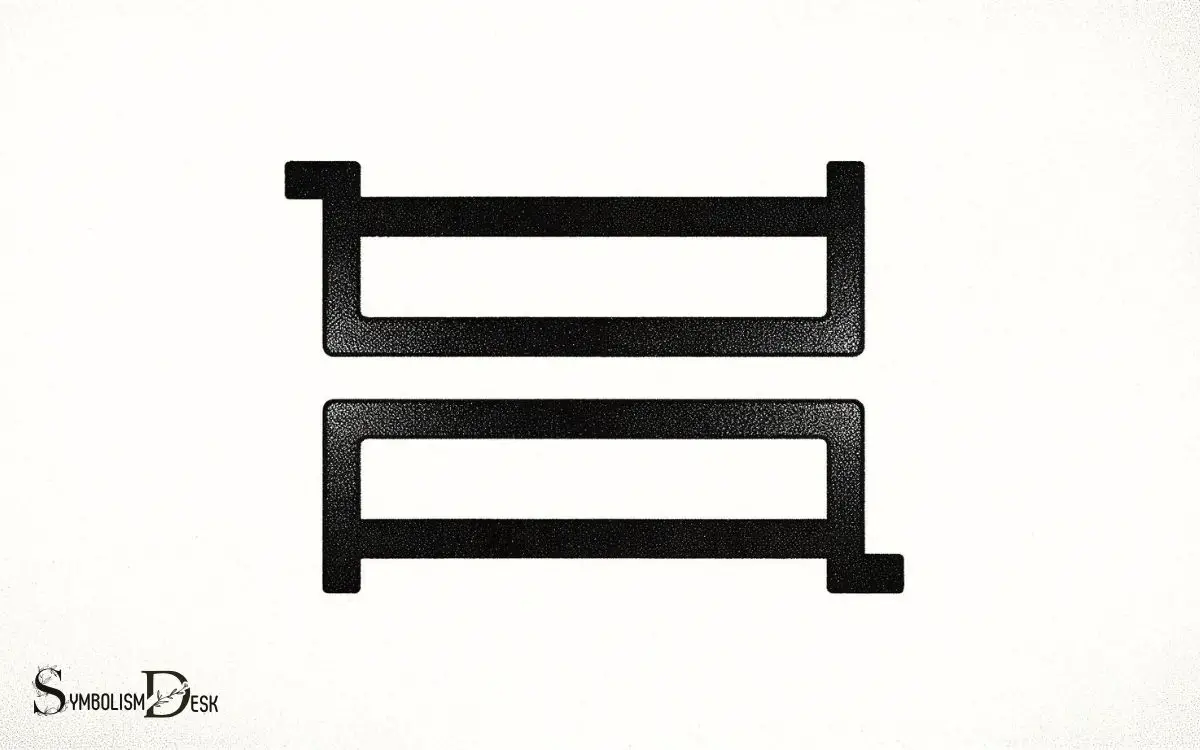Math Symbol for Same As: Quantity!
The mathematical symbol for ‘same as’ is the equals sign (=). This symbol denotes that two expressions represent the same value or quantity.
It is a cornerstone of arithmetic and algebra, and its correct use is vital for solving equations and proving mathematical theories.
The equals sign (=) was first used by Welsh mathematician Robert Recorde in 1557 to avoid the repetitiveness of writing “is equal to” in his equations.
The symbol is now universally recognized and used in various mathematical contexts, such as:
Common misconceptions include confusing the equals sign with approximation or equivalence symbols, which serve different purposes in mathematics.
Understanding the equals sign is crucial for mathematical literacy and forms the foundation of equation-based problem-solving.

Key Takeaway
Understanding the Equals Sign: Symbolism in Mathematics
| Symbol | Name | Meaning | Example |
|---|---|---|---|
| ( = ) | Equals | Indicates two expressions are the same | ( 3 + 1 = 4 ) |
| ( ) | Approximately | Indicates two values are close but not exactly the same | ( 3.14 ) |
| ( ) | Identical to | Denotes identical mathematical expressions or congruence | ( (2 imes 3) 6 ) |
The Origin of the Equal Sign
Tracing the origin of the equal sign leads to the 16th century when it was first introduced by Robert Recorde, a Welsh mathematician. Recorde used two parallel lines to indicate equality in a mathematical equation in his book “The Whetstone of Witte” published in 1557.
He chose this symbol because it was a reminder of balance and harmony in the equation. The symbol gained popularity and gradually evolved into the universally recognized “=” sign we use today.
Recorde’s introduction of the equal sign was a significant advancement in mathematical notation, simplifying the representation of mathematical relationships and paving the way for the development of algebraic concepts.
His contribution continues to play a fundamental role in mathematics and has become a cornerstone of mathematical communication and understanding.
The Meaning of the Equal Sign
The equal sign is a fundamental symbol of equivalence in mathematics, representing the balance between two sides of a mathematical expression.
Understanding the meaning of the equal sign is crucial in ensuring that mathematical equations maintain equality and accuracy in their solutions.
In the context of equations, the equal sign denotes the relationship of equality between two expressions, highlighting the values that make them equivalent.
Symbol of Equivalence
The symbol of equivalence, represented by the equal sign, is a foundational concept in mathematics allowing for the comparison and balance of mathematical expressions.
Understanding the meaning of the equal sign is crucial for solving equations and grasping the fundamental principles of algebra.
Here are some key aspects to consider:
- Balancing Equations: The equal sign indicates that the expressions on either side have the same value, allowing for the balancing of equations.
- Comparison: It is used to compare two expressions and determine if they are equivalent or not.
- Transitivity: The equal sign follows the transitive property, meaning if a = b and b = c, then a = c.
- Symbol of Identity: It signifies that two quantities are identical, even if they are expressed differently.
The equal sign is a powerful tool for expressing mathematical relationships and is essential for logical reasoning in mathematics.
Balanced Mathematical Expressions
Balanced mathematical expressions demonstrate the meaning of the equal sign in conveying equivalence between two quantities. In a balanced mathematical expression, the quantities on either side of the equal sign have the same value, but they may be represented in different ways. This concept is essential for understanding the foundational principles of algebra and solving equations. Just as the equal sign is a powerful symbol in mathematics, so too are symbols meaningful in other contexts, such as the Ukrainian flag symbol meaning, which represents the nation’s history and culture. The use of symbols is an essential part of communication and can convey complex ideas and concepts with just a simple image or representation.
The equal sign indicates that both sides of the expression hold the same value. Understanding this concept is crucial in solving mathematical problems and equations.
Here’s a simple example to illustrate this:
| Balanced Expression | Unbalanced Expression |
|---|---|
| 4 + 5 = 2 + 7 | 4 + 5 = 2 + 6 |
| 9 = 9 | 9 = 8 |
In the first row, the balanced expression shows that 4 + 5 is equal to 2 + 7, while the unbalanced expression demonstrates inequality.
Similarly, in the second row, the equal sign in the balanced expression signifies that 9 is indeed equal to 9, whereas in the unbalanced expression, 9 is incorrectly equated to 8.
Understanding the meaning of the equal sign is fundamental to mastering mathematical concepts.
Equality in Equations
Why is the understanding of the meaning of the equal sign fundamental in solving mathematical problems and equations?
The concept of equality is crucial for effectively solving equations and grasping the principles of mathematics.
Understanding the equal sign ensures that individuals comprehend the relationship between different expressions and how they correspond to each other.
This comprehension forms the basis for successfully manipulating equations and solving for unknown variables.
- The equal sign indicates that the expressions on either side have the same value.
- It allows for the comparison of two quantities or expressions.
- It forms the foundation for algebraic manipulation and solving for unknowns.
- Mastery of the equal sign is essential for progressing to more complex mathematical concepts and problem-solving techniques.
Notable Uses of the Equal Sign
One important application of the equal sign is to indicate that two mathematical expressions have the same value.
This concept is widely used in various mathematical and scientific fields. Notable uses of the equal sign include solving equations, expressing mathematical relationships, and stating the conditions for congruence in geometry.
Notable Uses of the Equal Sign
- Solving Equations
- Expressing Mathematical Relationships
- Conditions for Congruence in Geometry
The equal sign serves as a vital tool in mathematical communication, allowing for the concise representation of relationships between quantities. Understanding its various applications is fundamental to mastering mathematical concepts and problem-solving.
Properties of the Equal Sign
The equal sign is a fundamental symbol in mathematics, representing the concept of equality between two quantities. Understanding the properties of the equal sign is essential for solving equations and manipulating mathematical expressions.
In this discussion, we will explore the various properties of the equal sign and its implications for mathematical operations.
Equal Sign Meaning
The equal sign’s meaning and properties play a crucial role in mathematical equations and expressions. Understanding the properties of the equal sign is fundamental to solving equations and working with mathematical expressions.
Some key properties of the equal sign include:
- Symmetry: The equal sign is symmetric, meaning that the expressions on either side of the equal sign can be interchanged without affecting the truth of the equation.
- Transitivity: If two quantities are equal to a third quantity, then they are equal to each other.
- Reflexivity: Any quantity is equal to itself.
- Substitution: The equal sign allows for the substitution of one expression for another, preserving equality.
These properties form the foundation for the manipulation and solving of equations in mathematics, making the equal sign a powerful and essential symbol in the language of mathematics.
Equivalence Properties Explained
Equivalence properties of the equal sign encompass fundamental principles essential for manipulating and solving mathematical equations.
These properties are crucial for simplifying expressions and solving equations. Understanding these properties allows for the transformation of equations without changing their solutions.
The table below outlines the key equivalence properties of the equal sign:
| Property | Example | Explanation |
|---|---|---|
| Reflexive Property | a = a | Any quantity is equal to itself. |
| Symmetric Property | If a = b, then b = a | The order of equality can be reversed. |
| Transitive Property | If a = b and b = c, then a = c | Equality is transitive. |
| Substitution Property | If a = b, then a can be substituted for b in any equation | Values can be replaced by their equivalents. |
Understanding and applying these properties is fundamental in algebraic manipulation and problem-solving.
The Equal Sign in Equations
In mathematical equations, the equal sign serves to indicate the equivalence between two expressions. When working with the equal sign in equations, it’s essential to understand its role in expressing balance and sameness in mathematical relationships.
Here are some key points to consider:
- The equal sign asserts that the expressions on either side have the same value.
- It signifies a state of equilibrium between the two sides of the equation.
- When solving equations, operations performed on one side must also be applied to the other to maintain equality.
- The equal sign is fundamental in representing the relationships between variables and constants in mathematical statements.
Understanding the significance of the equal sign is crucial for effectively solving equations and grasping foundational mathematical concepts.
Using the Equal Sign in Inequalities
When working with inequalities, the equal sign is used to denote a comparison between two expressions, indicating that one is greater than or less than the other.
In inequalities, the equal sign, along with the greater than (>) and less than (<) symbols, helps to express relationships between different values.
For instance, in “x < 5”, the inequality states that ‘x’ is less than 5. When the equal sign is included, as in “x ≤ 5”, it indicates that ‘x’ is less than or equal to 5.
Similarly, “y > 8” signifies that ‘y’ is greater than 8, while “y ≥ 8” means that ‘y’ is greater than or equal to 8. Understanding the use of the equal sign in inequalities is crucial for interpreting and solving mathematical problems involving relative values.
The Equal Sign in Algebraic Expressions
An essential component in algebraic expressions, the equal sign signifies a relationship of equivalence or inequality between two mathematical expressions, further extending the comparison principles discussed in the previous subtopic.
When working with algebraic expressions, the equal sign is used to denote that two expressions have the same value.
This concept is fundamental in solving equations and understanding the relationships between different quantities.
The equal sign allows for the manipulation of expressions to isolate variables and solve for unknowns. It forms the basis for building equations and solving for variables.
Understanding the properties of the equal sign is crucial for mastering algebraic manipulations and problem-solving techniques.
Misconceptions About the Equal Sign
The concept of the equal sign in algebraic expressions forms the foundation for understanding and addressing common misconceptions about its usage.
One common misconception is the belief that the equal sign simply indicates the answer to a problem, rather than expressing a relationship of equivalence between two expressions.
This misinterpretation can lead to errors in problem-solving and a lack of understanding of the fundamental principles of algebra.
Another misconception is the idea that the equal sign always implies a static relationship, when in fact it can represent dynamic processes and changing values.
Understanding these misconceptions is crucial for students to develop a solid grasp of algebraic concepts and to apply them accurately in mathematical reasoning and problem-solving.
Conclusion
The equal sign serves as a fundamental symbol in mathematics to denote equivalence and balance. Its origins date back to the 16th century, and it is used in various mathematical concepts such as equations, inequalities, and algebraic expressions.
Understanding the properties and meanings of the equal sign is crucial for mastering mathematical concepts and problem-solving.
Just as the equal sign brings balance to mathematical equations, it also brings clarity and coherence to the language of mathematics.






